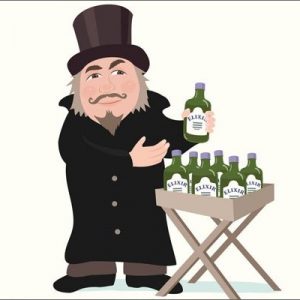A blog reader, thank you!, told me about a study (same title as my post) that was recently published in the Journal of the National Cancer Institute and that has been picked up by a whole slew of online news sources and blogs, some with ominous titles such as “Alternative medicine kills cancer patients” or “Alternative medicine can kill you.”
So what’s all the fuss about? Should we be concerned?
Here’s the gist: a team of four Yale researchers carried out an observational case control study, comparing 280 cancer patients who had chosen to use ONLY alternative therapies to 560 patients who had instead received conventional cancer treatments. They noted how many patients lived for at least five years and found that those in the AM group had a greater risk (about 50%) of dying compared to those in the CCT group.
The researchers therefore concluded that using alternative instead of conventional medicine to treat “nonmetastatic,” “curable” cancers, including breast, prostate, and colorectal cancer, increases a patient’s likelihood of dying.
Here’s the link to the abstract: http://goo.gl/Gtx5Gp
Someday, I’d like to read the full study, but for this post, I relied on online news sources, reliable ones, which I normally would prefer not to do…but I don’t have much time right now, and I have lots to say, so here is one of the sources I used, a Yale source: http://goo.gl/GXc5jx
As you may have gathered, I have a few (big) issues with this study. Here goes:
First and foremost, I have a question for my blog-reading statistics experts: shouldn’t the two groups have been the same in size? I mean, the researchers compared a group of 280 patients to one that was twice its size = 560 patients. Doesn’t size matter sometimes??? [Okay, I just read online that a sample size imbalance doesn’t mean that the study isn’t accurate, from a statistical point of view, even though comparing groups of equal size is preferable. But the statistics article I read online was referring to minor differences in size, not huge ones, as in this study, so I’m keeping my question on size…]
Secondly, and more importantly, the researchers did NOT include any DATA concerning the TYPE of alternative treatments chosen by the group of AM patients. We don’t know if these folks were using homeopathic remedies or herbal extracts, if they were juicing all their food, or if they were carrying so-called healing stones around in their pockets. It doesn’t take an Einstein to realize that this sort of data is absolutely CRUCIAL to a study like this one…
Why? Because alternative treatments are not all the same. There is an enormous difference between waving crystals in the air (or whatever you do with crystals…I have to admit I have no idea) AND taking a scientifically-backed extract that has been tested in clinical trials.
Not to mention all the revolting quacks and charlatans who make millions by exploiting the understandable fears that we, cancer patients, have of suffering and dying. What if all of these patients had been following the advice of quacks and charlatans? 
I was annoyed by the fact that these researchers were able to find out that the AM folks tend to be wealthier and better educated than the CCT folks, but didn’t make the extra effort to provide any data on the types of alternative treatments used by the former.
And so they chose to lump “alternative medicine” into one big category. Well, why the heck not? It makes things so much easier, doesn’t it? And besides, who would question a study like this one, whose results, based on a small sample (when you think about it), have provided all these juicy, scary headlines? Not very many people, methinks. Indeed, I haven’t yet found ONE SINGLE criticism online…Not one.
Sheeeeeesh!!!!!!!!!!
Okay, let’s move on to a rather interesting note: the researchers identified the types of cancer considered in their study as “curable.” I stopped short when I read that. Curable? I thought only testicular cancer was actually curable.
Well, again, if you read the statistics, as I did this morning, you will find that many types of cancer are considered to be “cured” if they don’t come back for a certain number of years (five years, I think) after conventional cancer treatments. And so the cancers in this study are considered “curable” IF caught and treated early on.
But what happens after the five year benchmark? Hmmm…
And another consideration: how are the folks in the AM group doing compared to those in the CCT group?
What’s their QUALITY OF LIFE (QOL), for starters?
Speaking of which…a personal note: my father-in-law, who was diagnosed with invasive melanoma in 2010, was considered to be a total success story by his oncologist, even though the conventional treatments he’d undergone had left him with terrible side effects that condemned him to a prolonged and agonizing death. But for conventional medicine, my father in law was “cured.”
Anyway, I don’t want to get into that. It’s not the point of this post. It’s just that this “cure” business drives me absolutely bonkers, sometimes, since it doesn’t take into account so many important aspects, such as QOL, as I mentioned above. I don’t know about you, but QOL is verrrrrrrrrrrrrrrrrrrrrrrrrrrry important to me…
I’d like to end this post, which has gotten me rambling a bit all over the place (sorry about that!!!), with a few more, perhaps obvious!, comments.
These data-based studies are supremely annoying…and meaningless…useless, really, since a lot of what I consider to be important information (QOL, etc.) on the patients is missing. Totally missing.
Just my opinion, as usual!!!
P.S. By the way, I could mention the fact that two of the four researchers had received grants from companies providing conventional cancer treatments, and one researcher had a grant from a large cancer treatment center. But I won’t. (Oh, gee, I guess I just did! 😉 )